Analyzing the Deepwater Horizon Disaster Using the Diamond Model
VerifiedAdded on 2023/03/23
|23
|5164
|21
Project
AI Summary
This project analyzes the Deepwater Horizon disaster, focusing on the application of the Diamond Model to understand the project's complexities. The study begins with an executive summary outlining the oil spill and its significance as a major industrial disaster, emphasizing the need for conceptual theories and tools to evaluate the project's dimensions. The introduction identifies the core issues, including the flawed plan and the failure of the blowout preventer (BOP), highlighting the environmental impact and ongoing efforts to limit the oil flow. The analysis then delves into the Diamond Model, examining its dimensions of novelty, technology, complexity, and pace. The study explains how each dimension is used to assess the project's uncertainties and make informed decisions. The project then elaborates on each aspect of the Diamond Model, detailing the different levels of novelty (breakthrough, platform, and derivative), technological uncertainties (super high-tech, high-tech, medium-tech, and low-tech), complexity (arrays, systems, and assembly), and pace (blitz, time-critical, competitive, and regular). Finally, the project justifies the use of the Diamond Model in understanding the Deepwater Horizon disaster, emphasizing its usefulness in making decisions about project management, determining the risks and managing them accordingly. The challenges of the Diamond Model are also briefly discussed, highlighting the adaptive project management approach.
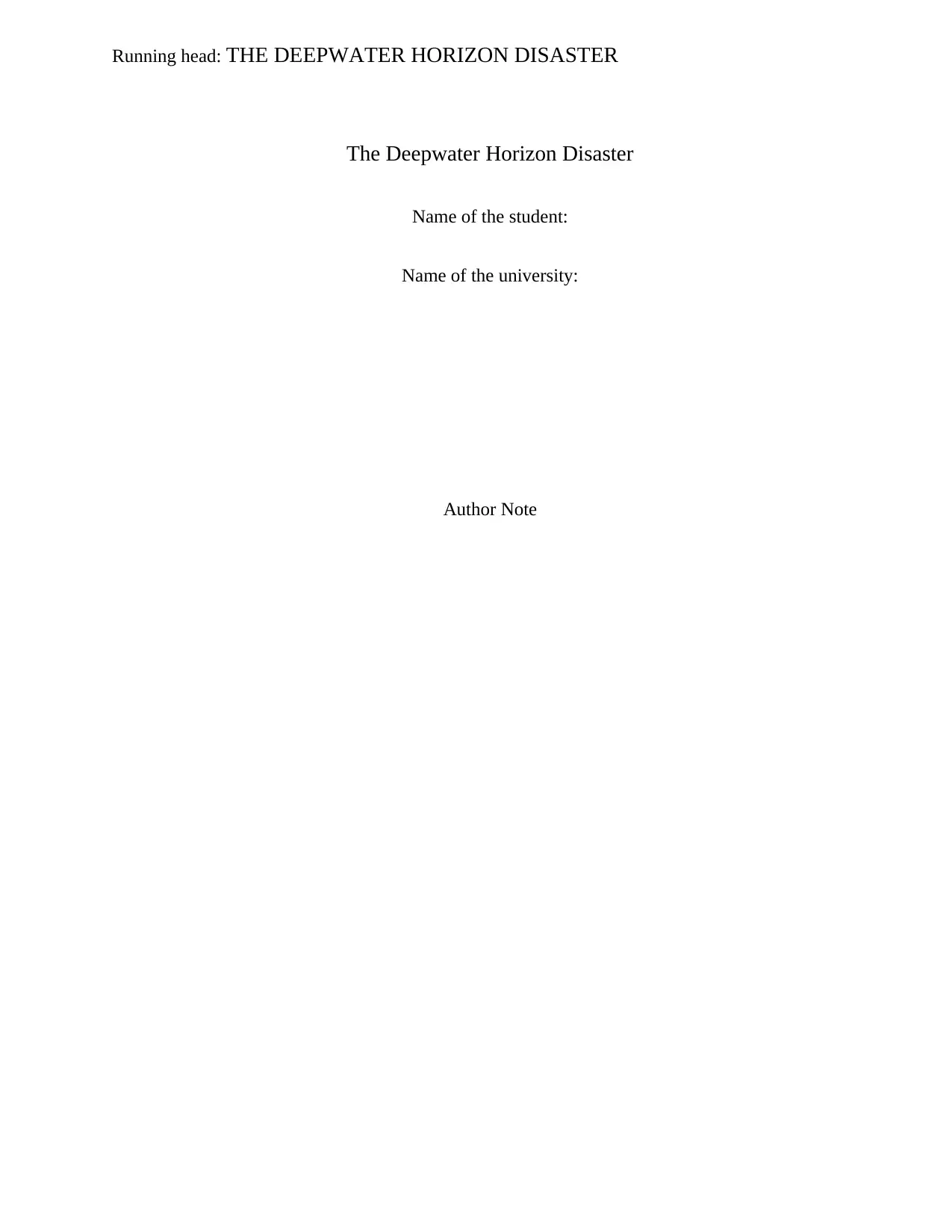
Running head: THE DEEPWATER HORIZON DISASTER
The Deepwater Horizon Disaster
Name of the student:
Name of the university:
Author Note
The Deepwater Horizon Disaster
Name of the student:
Name of the university:
Author Note
Paraphrase This Document
Need a fresh take? Get an instant paraphrase of this document with our AI Paraphraser

1THE DEEPWATER HORIZON DISASTER
Executive summary
The Deepwater Horizon s widespread oil spill that was established in 2010. This is one of the most
massive marine spill having greatest marine sill and the popular industrial disaster in history. Here,
in this study evaluation is made on the relevant project complexities. Further, different concepts and
theories that are applicable here are demonstrated.
Executive summary
The Deepwater Horizon s widespread oil spill that was established in 2010. This is one of the most
massive marine spill having greatest marine sill and the popular industrial disaster in history. Here,
in this study evaluation is made on the relevant project complexities. Further, different concepts and
theories that are applicable here are demonstrated.

2THE DEEPWATER HORIZON DISASTER
Table of Contents
Component 1: Introduction:...................................................................................................................3
Component 2: Analysis of the kind of project complexity related to the present case:........................4
Component 3: Selection of the model:..................................................................................................5
Component 4: Conclusion:..................................................................................................................10
References:..........................................................................................................................................11
Appendix:............................................................................................................................................14
Appendix 1:.....................................................................................................................................14
Appendix 2:.....................................................................................................................................15
Appendix 3:.....................................................................................................................................17
Appendix 4:.....................................................................................................................................18
Table of Contents
Component 1: Introduction:...................................................................................................................3
Component 2: Analysis of the kind of project complexity related to the present case:........................4
Component 3: Selection of the model:..................................................................................................5
Component 4: Conclusion:..................................................................................................................10
References:..........................................................................................................................................11
Appendix:............................................................................................................................................14
Appendix 1:.....................................................................................................................................14
Appendix 2:.....................................................................................................................................15
Appendix 3:.....................................................................................................................................17
Appendix 4:.....................................................................................................................................18
⊘ This is a preview!⊘
Do you want full access?
Subscribe today to unlock all pages.

Trusted by 1+ million students worldwide
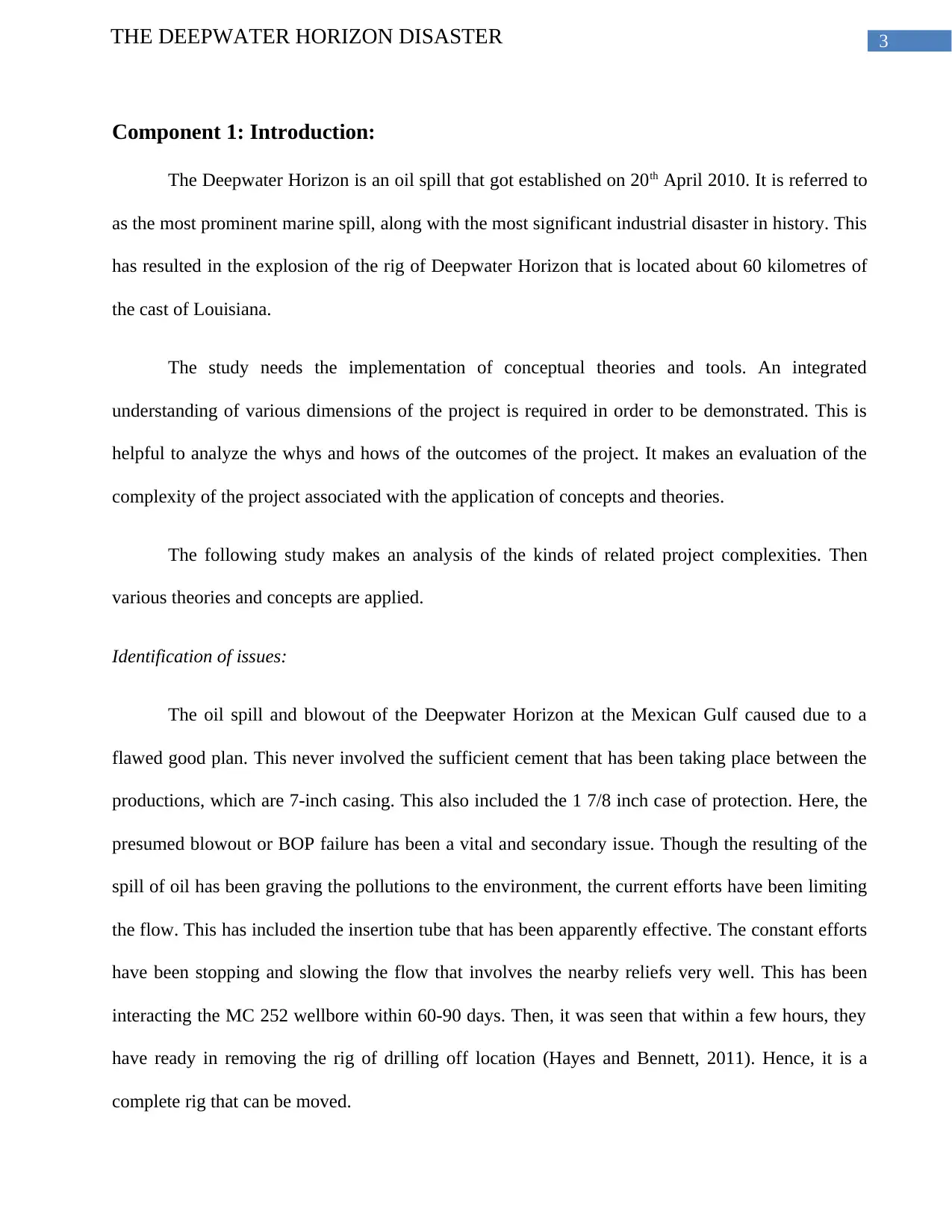
3THE DEEPWATER HORIZON DISASTER
Component 1: Introduction:
The Deepwater Horizon is an oil spill that got established on 20th April 2010. It is referred to
as the most prominent marine spill, along with the most significant industrial disaster in history. This
has resulted in the explosion of the rig of Deepwater Horizon that is located about 60 kilometres of
the cast of Louisiana.
The study needs the implementation of conceptual theories and tools. An integrated
understanding of various dimensions of the project is required in order to be demonstrated. This is
helpful to analyze the whys and hows of the outcomes of the project. It makes an evaluation of the
complexity of the project associated with the application of concepts and theories.
The following study makes an analysis of the kinds of related project complexities. Then
various theories and concepts are applied.
Identification of issues:
The oil spill and blowout of the Deepwater Horizon at the Mexican Gulf caused due to a
flawed good plan. This never involved the sufficient cement that has been taking place between the
productions, which are 7-inch casing. This also included the 1 7/8 inch case of protection. Here, the
presumed blowout or BOP failure has been a vital and secondary issue. Though the resulting of the
spill of oil has been graving the pollutions to the environment, the current efforts have been limiting
the flow. This has included the insertion tube that has been apparently effective. The constant efforts
have been stopping and slowing the flow that involves the nearby reliefs very well. This has been
interacting the MC 252 wellbore within 60-90 days. Then, it was seen that within a few hours, they
have ready in removing the rig of drilling off location (Hayes and Bennett, 2011). Hence, it is a
complete rig that can be moved.
Component 1: Introduction:
The Deepwater Horizon is an oil spill that got established on 20th April 2010. It is referred to
as the most prominent marine spill, along with the most significant industrial disaster in history. This
has resulted in the explosion of the rig of Deepwater Horizon that is located about 60 kilometres of
the cast of Louisiana.
The study needs the implementation of conceptual theories and tools. An integrated
understanding of various dimensions of the project is required in order to be demonstrated. This is
helpful to analyze the whys and hows of the outcomes of the project. It makes an evaluation of the
complexity of the project associated with the application of concepts and theories.
The following study makes an analysis of the kinds of related project complexities. Then
various theories and concepts are applied.
Identification of issues:
The oil spill and blowout of the Deepwater Horizon at the Mexican Gulf caused due to a
flawed good plan. This never involved the sufficient cement that has been taking place between the
productions, which are 7-inch casing. This also included the 1 7/8 inch case of protection. Here, the
presumed blowout or BOP failure has been a vital and secondary issue. Though the resulting of the
spill of oil has been graving the pollutions to the environment, the current efforts have been limiting
the flow. This has included the insertion tube that has been apparently effective. The constant efforts
have been stopping and slowing the flow that involves the nearby reliefs very well. This has been
interacting the MC 252 wellbore within 60-90 days. Then, it was seen that within a few hours, they
have ready in removing the rig of drilling off location (Hayes and Bennett, 2011). Hence, it is a
complete rig that can be moved.
Paraphrase This Document
Need a fresh take? Get an instant paraphrase of this document with our AI Paraphraser
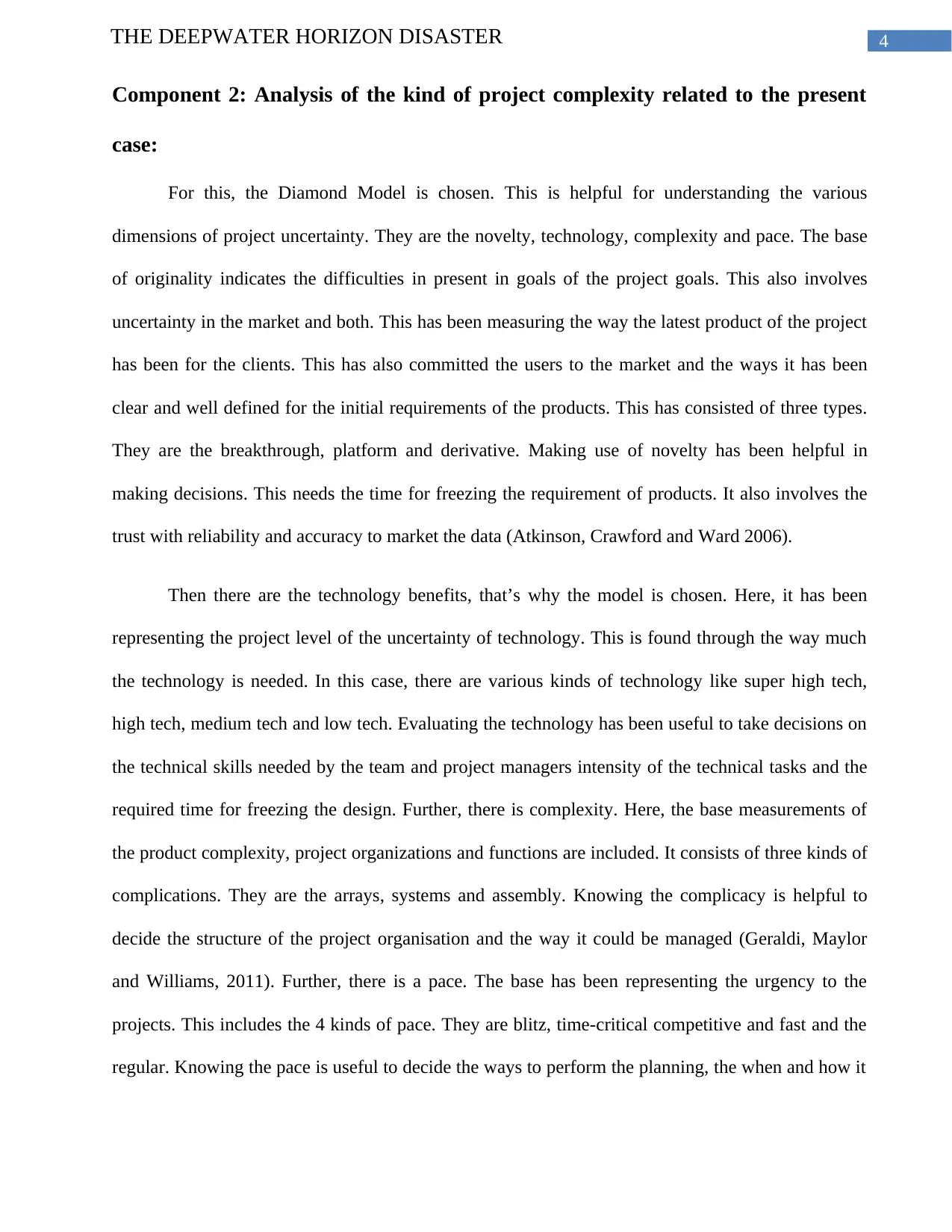
4THE DEEPWATER HORIZON DISASTER
Component 2: Analysis of the kind of project complexity related to the present
case:
For this, the Diamond Model is chosen. This is helpful for understanding the various
dimensions of project uncertainty. They are the novelty, technology, complexity and pace. The base
of originality indicates the difficulties in present in goals of the project goals. This also involves
uncertainty in the market and both. This has been measuring the way the latest product of the project
has been for the clients. This has also committed the users to the market and the ways it has been
clear and well defined for the initial requirements of the products. This has consisted of three types.
They are the breakthrough, platform and derivative. Making use of novelty has been helpful in
making decisions. This needs the time for freezing the requirement of products. It also involves the
trust with reliability and accuracy to market the data (Atkinson, Crawford and Ward 2006).
Then there are the technology benefits, that’s why the model is chosen. Here, it has been
representing the project level of the uncertainty of technology. This is found through the way much
the technology is needed. In this case, there are various kinds of technology like super high tech,
high tech, medium tech and low tech. Evaluating the technology has been useful to take decisions on
the technical skills needed by the team and project managers intensity of the technical tasks and the
required time for freezing the design. Further, there is complexity. Here, the base measurements of
the product complexity, project organizations and functions are included. It consists of three kinds of
complications. They are the arrays, systems and assembly. Knowing the complicacy is helpful to
decide the structure of the project organisation and the way it could be managed (Geraldi, Maylor
and Williams, 2011). Further, there is a pace. The base has been representing the urgency to the
projects. This includes the 4 kinds of pace. They are blitz, time-critical competitive and fast and the
regular. Knowing the pace is useful to decide the ways to perform the planning, the when and how it
Component 2: Analysis of the kind of project complexity related to the present
case:
For this, the Diamond Model is chosen. This is helpful for understanding the various
dimensions of project uncertainty. They are the novelty, technology, complexity and pace. The base
of originality indicates the difficulties in present in goals of the project goals. This also involves
uncertainty in the market and both. This has been measuring the way the latest product of the project
has been for the clients. This has also committed the users to the market and the ways it has been
clear and well defined for the initial requirements of the products. This has consisted of three types.
They are the breakthrough, platform and derivative. Making use of novelty has been helpful in
making decisions. This needs the time for freezing the requirement of products. It also involves the
trust with reliability and accuracy to market the data (Atkinson, Crawford and Ward 2006).
Then there are the technology benefits, that’s why the model is chosen. Here, it has been
representing the project level of the uncertainty of technology. This is found through the way much
the technology is needed. In this case, there are various kinds of technology like super high tech,
high tech, medium tech and low tech. Evaluating the technology has been useful to take decisions on
the technical skills needed by the team and project managers intensity of the technical tasks and the
required time for freezing the design. Further, there is complexity. Here, the base measurements of
the product complexity, project organizations and functions are included. It consists of three kinds of
complications. They are the arrays, systems and assembly. Knowing the complicacy is helpful to
decide the structure of the project organisation and the way it could be managed (Geraldi, Maylor
and Williams, 2011). Further, there is a pace. The base has been representing the urgency to the
projects. This includes the 4 kinds of pace. They are blitz, time-critical competitive and fast and the
regular. Knowing the pace is useful to decide the ways to perform the planning, the when and how it
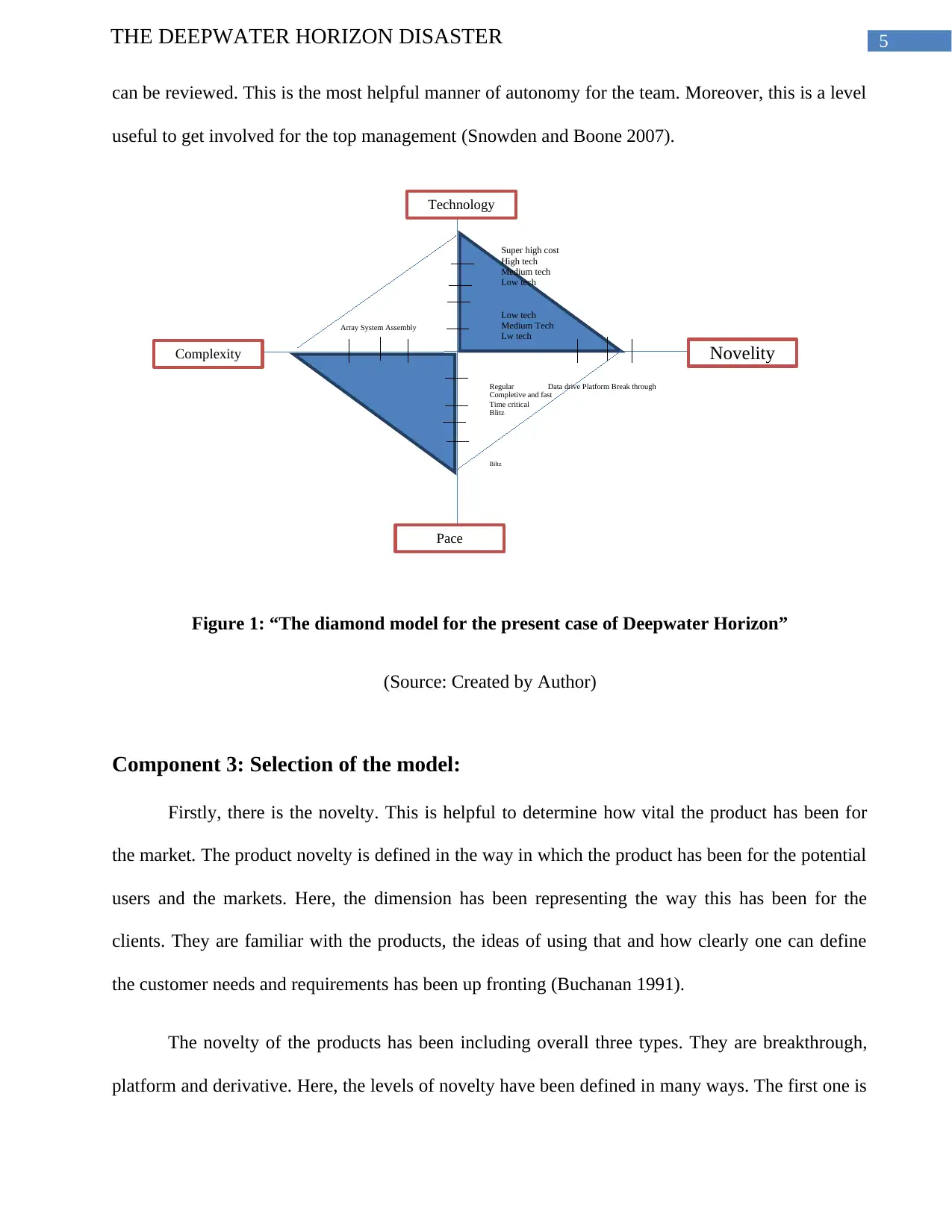
5THE DEEPWATER HORIZON DISASTER
Technology
Pace
Complexity Novelity
Super high cost
High tech
Medium tech
Low tech
Low tech
Medium Tech
Lw tech
Regular
Completive and fast
Time critical
Blitz
Biltz
Data drive Platform Break through
Array System Assembly
can be reviewed. This is the most helpful manner of autonomy for the team. Moreover, this is a level
useful to get involved for the top management (Snowden and Boone 2007).
Figure 1: “The diamond model for the present case of Deepwater Horizon”
(Source: Created by Author)
Component 3: Selection of the model:
Firstly, there is the novelty. This is helpful to determine how vital the product has been for
the market. The product novelty is defined in the way in which the product has been for the potential
users and the markets. Here, the dimension has been representing the way this has been for the
clients. They are familiar with the products, the ideas of using that and how clearly one can define
the customer needs and requirements has been up fronting (Buchanan 1991).
The novelty of the products has been including overall three types. They are breakthrough,
platform and derivative. Here, the levels of novelty have been defined in many ways. The first one is
Technology
Pace
Complexity Novelity
Super high cost
High tech
Medium tech
Low tech
Low tech
Medium Tech
Lw tech
Regular
Completive and fast
Time critical
Blitz
Biltz
Data drive Platform Break through
Array System Assembly
can be reviewed. This is the most helpful manner of autonomy for the team. Moreover, this is a level
useful to get involved for the top management (Snowden and Boone 2007).
Figure 1: “The diamond model for the present case of Deepwater Horizon”
(Source: Created by Author)
Component 3: Selection of the model:
Firstly, there is the novelty. This is helpful to determine how vital the product has been for
the market. The product novelty is defined in the way in which the product has been for the potential
users and the markets. Here, the dimension has been representing the way this has been for the
clients. They are familiar with the products, the ideas of using that and how clearly one can define
the customer needs and requirements has been up fronting (Buchanan 1991).
The novelty of the products has been including overall three types. They are breakthrough,
platform and derivative. Here, the levels of novelty have been defined in many ways. The first one is
⊘ This is a preview!⊘
Do you want full access?
Subscribe today to unlock all pages.

Trusted by 1+ million students worldwide
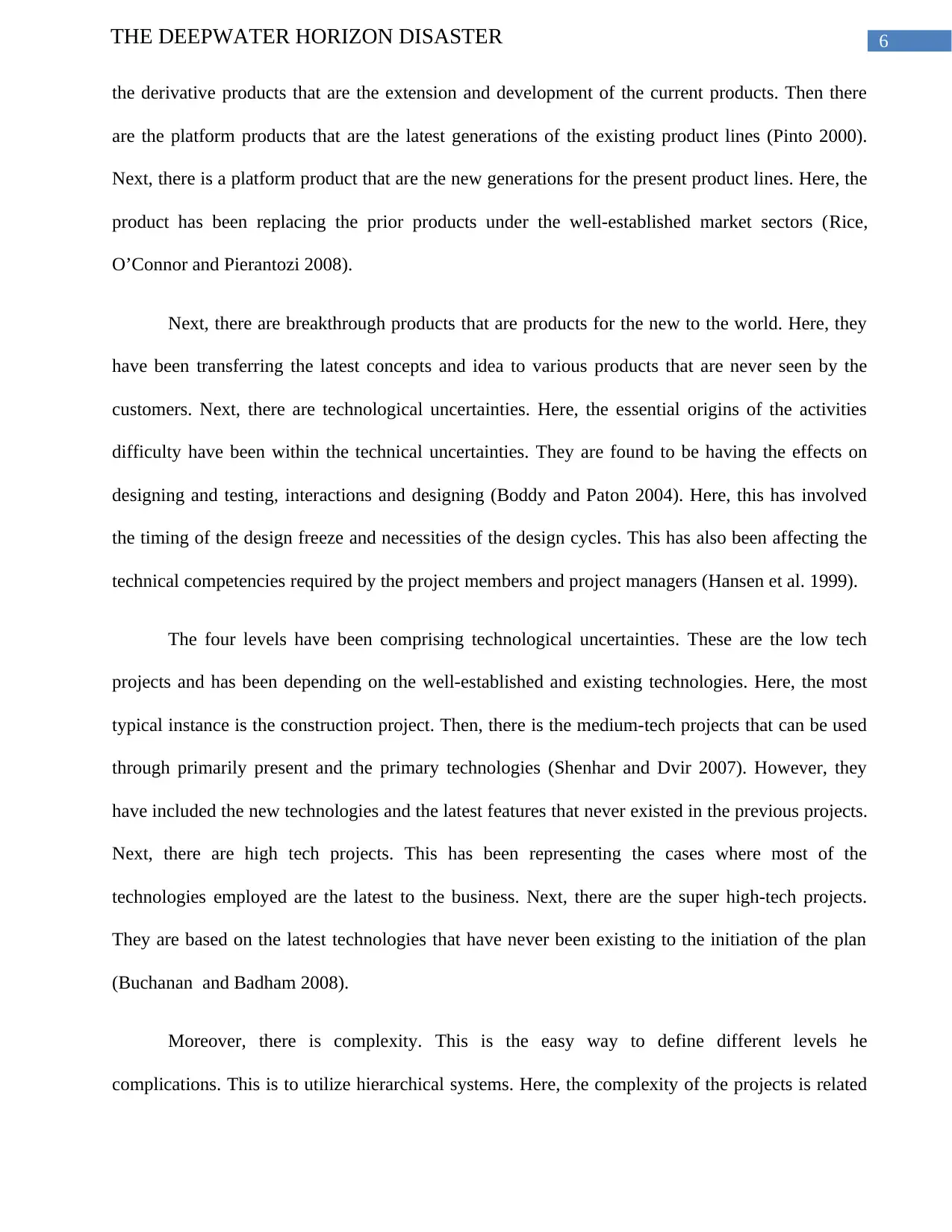
6THE DEEPWATER HORIZON DISASTER
the derivative products that are the extension and development of the current products. Then there
are the platform products that are the latest generations of the existing product lines (Pinto 2000).
Next, there is a platform product that are the new generations for the present product lines. Here, the
product has been replacing the prior products under the well-established market sectors (Rice,
O’Connor and Pierantozi 2008).
Next, there are breakthrough products that are products for the new to the world. Here, they
have been transferring the latest concepts and idea to various products that are never seen by the
customers. Next, there are technological uncertainties. Here, the essential origins of the activities
difficulty have been within the technical uncertainties. They are found to be having the effects on
designing and testing, interactions and designing (Boddy and Paton 2004). Here, this has involved
the timing of the design freeze and necessities of the design cycles. This has also been affecting the
technical competencies required by the project members and project managers (Hansen et al. 1999).
The four levels have been comprising technological uncertainties. These are the low tech
projects and has been depending on the well-established and existing technologies. Here, the most
typical instance is the construction project. Then, there is the medium-tech projects that can be used
through primarily present and the primary technologies (Shenhar and Dvir 2007). However, they
have included the new technologies and the latest features that never existed in the previous projects.
Next, there are high tech projects. This has been representing the cases where most of the
technologies employed are the latest to the business. Next, there are the super high-tech projects.
They are based on the latest technologies that have never been existing to the initiation of the plan
(Buchanan and Badham 2008).
Moreover, there is complexity. This is the easy way to define different levels he
complications. This is to utilize hierarchical systems. Here, the complexity of the projects is related
the derivative products that are the extension and development of the current products. Then there
are the platform products that are the latest generations of the existing product lines (Pinto 2000).
Next, there is a platform product that are the new generations for the present product lines. Here, the
product has been replacing the prior products under the well-established market sectors (Rice,
O’Connor and Pierantozi 2008).
Next, there are breakthrough products that are products for the new to the world. Here, they
have been transferring the latest concepts and idea to various products that are never seen by the
customers. Next, there are technological uncertainties. Here, the essential origins of the activities
difficulty have been within the technical uncertainties. They are found to be having the effects on
designing and testing, interactions and designing (Boddy and Paton 2004). Here, this has involved
the timing of the design freeze and necessities of the design cycles. This has also been affecting the
technical competencies required by the project members and project managers (Hansen et al. 1999).
The four levels have been comprising technological uncertainties. These are the low tech
projects and has been depending on the well-established and existing technologies. Here, the most
typical instance is the construction project. Then, there is the medium-tech projects that can be used
through primarily present and the primary technologies (Shenhar and Dvir 2007). However, they
have included the new technologies and the latest features that never existed in the previous projects.
Next, there are high tech projects. This has been representing the cases where most of the
technologies employed are the latest to the business. Next, there are the super high-tech projects.
They are based on the latest technologies that have never been existing to the initiation of the plan
(Buchanan and Badham 2008).
Moreover, there is complexity. This is the easy way to define different levels he
complications. This is to utilize hierarchical systems. Here, the complexity of the projects is related
Paraphrase This Document
Need a fresh take? Get an instant paraphrase of this document with our AI Paraphraser
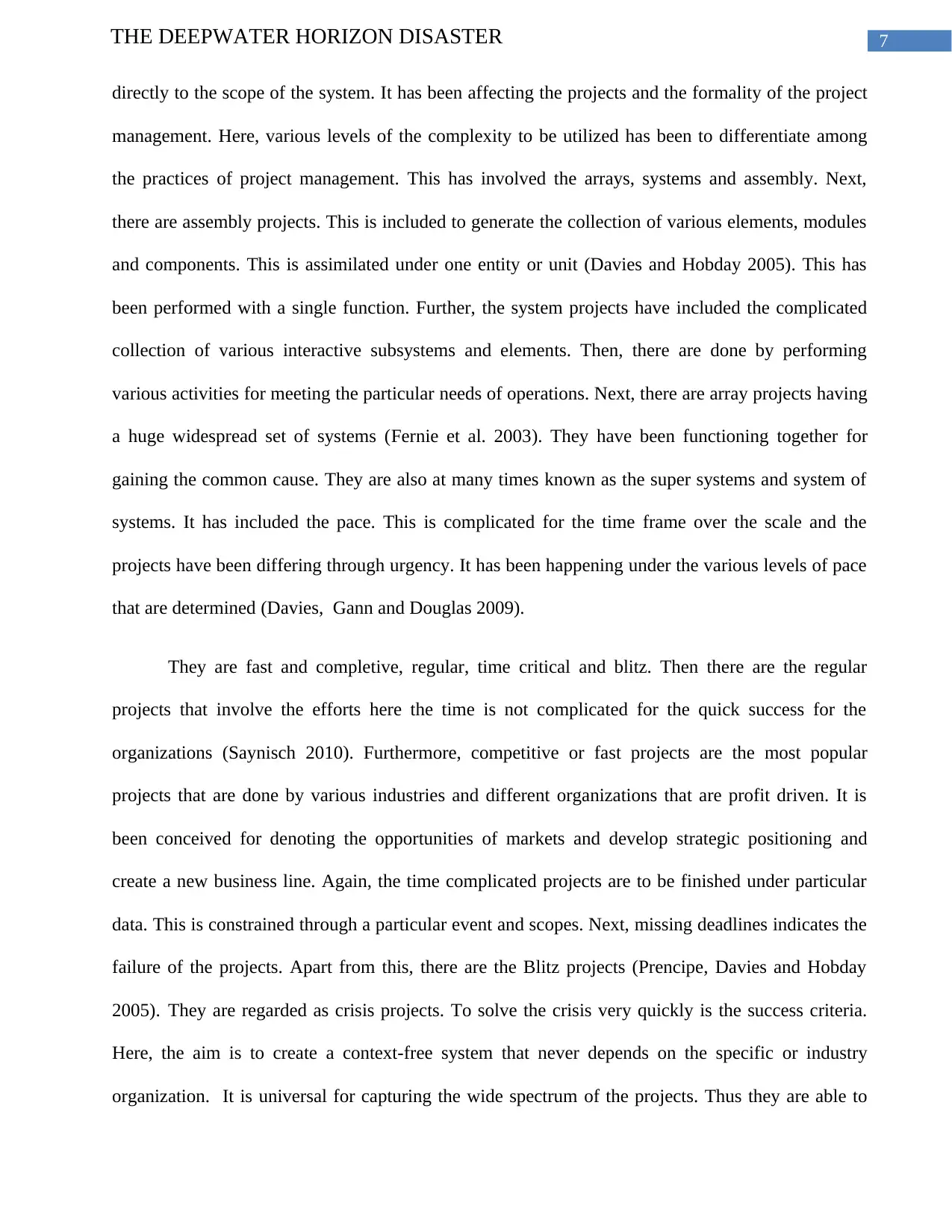
7THE DEEPWATER HORIZON DISASTER
directly to the scope of the system. It has been affecting the projects and the formality of the project
management. Here, various levels of the complexity to be utilized has been to differentiate among
the practices of project management. This has involved the arrays, systems and assembly. Next,
there are assembly projects. This is included to generate the collection of various elements, modules
and components. This is assimilated under one entity or unit (Davies and Hobday 2005). This has
been performed with a single function. Further, the system projects have included the complicated
collection of various interactive subsystems and elements. Then, there are done by performing
various activities for meeting the particular needs of operations. Next, there are array projects having
a huge widespread set of systems (Fernie et al. 2003). They have been functioning together for
gaining the common cause. They are also at many times known as the super systems and system of
systems. It has included the pace. This is complicated for the time frame over the scale and the
projects have been differing through urgency. It has been happening under the various levels of pace
that are determined (Davies, Gann and Douglas 2009).
They are fast and completive, regular, time critical and blitz. Then there are the regular
projects that involve the efforts here the time is not complicated for the quick success for the
organizations (Saynisch 2010). Furthermore, competitive or fast projects are the most popular
projects that are done by various industries and different organizations that are profit driven. It is
been conceived for denoting the opportunities of markets and develop strategic positioning and
create a new business line. Again, the time complicated projects are to be finished under particular
data. This is constrained through a particular event and scopes. Next, missing deadlines indicates the
failure of the projects. Apart from this, there are the Blitz projects (Prencipe, Davies and Hobday
2005). They are regarded as crisis projects. To solve the crisis very quickly is the success criteria.
Here, the aim is to create a context-free system that never depends on the specific or industry
organization. It is universal for capturing the wide spectrum of the projects. Thus they are able to
directly to the scope of the system. It has been affecting the projects and the formality of the project
management. Here, various levels of the complexity to be utilized has been to differentiate among
the practices of project management. This has involved the arrays, systems and assembly. Next,
there are assembly projects. This is included to generate the collection of various elements, modules
and components. This is assimilated under one entity or unit (Davies and Hobday 2005). This has
been performed with a single function. Further, the system projects have included the complicated
collection of various interactive subsystems and elements. Then, there are done by performing
various activities for meeting the particular needs of operations. Next, there are array projects having
a huge widespread set of systems (Fernie et al. 2003). They have been functioning together for
gaining the common cause. They are also at many times known as the super systems and system of
systems. It has included the pace. This is complicated for the time frame over the scale and the
projects have been differing through urgency. It has been happening under the various levels of pace
that are determined (Davies, Gann and Douglas 2009).
They are fast and completive, regular, time critical and blitz. Then there are the regular
projects that involve the efforts here the time is not complicated for the quick success for the
organizations (Saynisch 2010). Furthermore, competitive or fast projects are the most popular
projects that are done by various industries and different organizations that are profit driven. It is
been conceived for denoting the opportunities of markets and develop strategic positioning and
create a new business line. Again, the time complicated projects are to be finished under particular
data. This is constrained through a particular event and scopes. Next, missing deadlines indicates the
failure of the projects. Apart from this, there are the Blitz projects (Prencipe, Davies and Hobday
2005). They are regarded as crisis projects. To solve the crisis very quickly is the success criteria.
Here, the aim is to create a context-free system that never depends on the specific or industry
organization. It is universal for capturing the wide spectrum of the projects. Thus they are able to
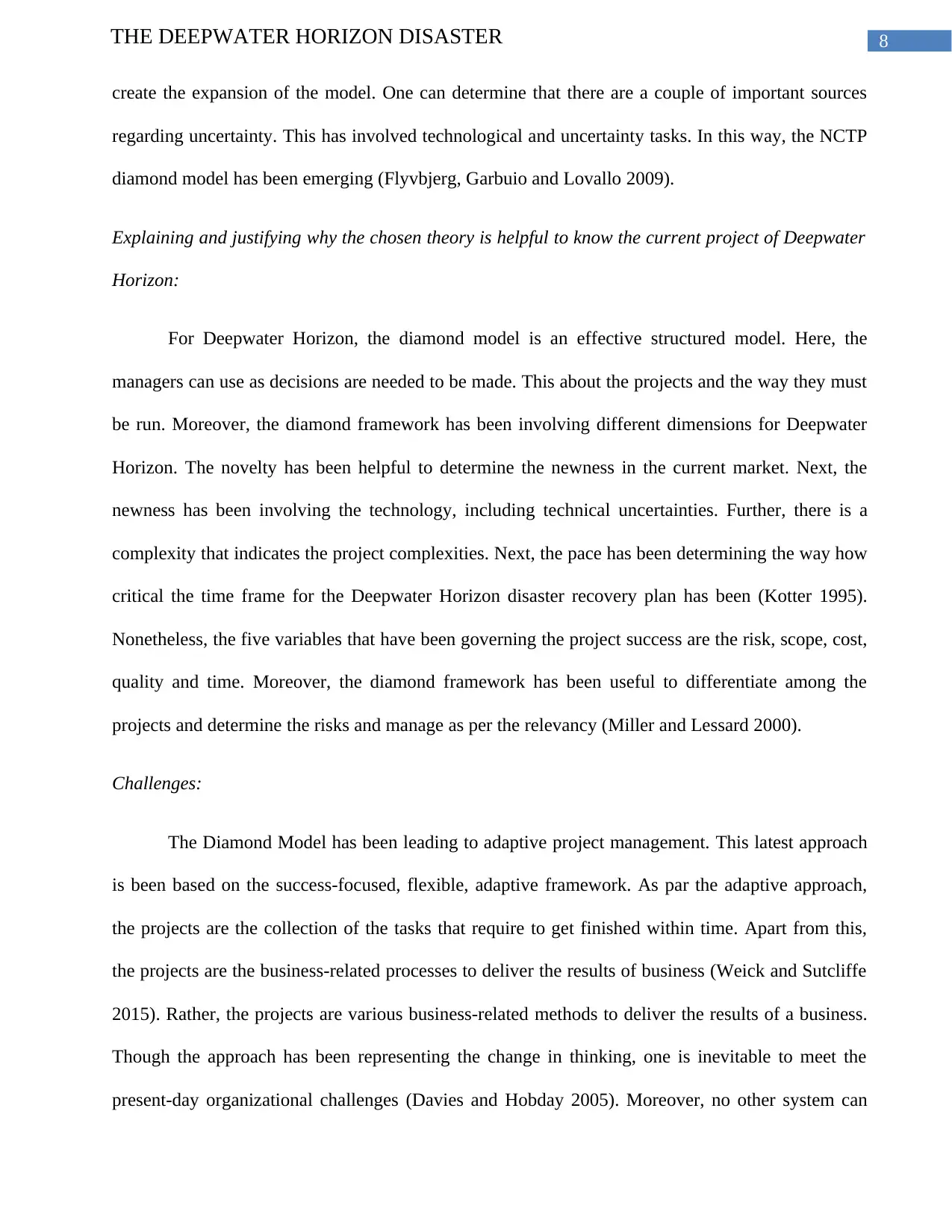
8THE DEEPWATER HORIZON DISASTER
create the expansion of the model. One can determine that there are a couple of important sources
regarding uncertainty. This has involved technological and uncertainty tasks. In this way, the NCTP
diamond model has been emerging (Flyvbjerg, Garbuio and Lovallo 2009).
Explaining and justifying why the chosen theory is helpful to know the current project of Deepwater
Horizon:
For Deepwater Horizon, the diamond model is an effective structured model. Here, the
managers can use as decisions are needed to be made. This about the projects and the way they must
be run. Moreover, the diamond framework has been involving different dimensions for Deepwater
Horizon. The novelty has been helpful to determine the newness in the current market. Next, the
newness has been involving the technology, including technical uncertainties. Further, there is a
complexity that indicates the project complexities. Next, the pace has been determining the way how
critical the time frame for the Deepwater Horizon disaster recovery plan has been (Kotter 1995).
Nonetheless, the five variables that have been governing the project success are the risk, scope, cost,
quality and time. Moreover, the diamond framework has been useful to differentiate among the
projects and determine the risks and manage as per the relevancy (Miller and Lessard 2000).
Challenges:
The Diamond Model has been leading to adaptive project management. This latest approach
is been based on the success-focused, flexible, adaptive framework. As par the adaptive approach,
the projects are the collection of the tasks that require to get finished within time. Apart from this,
the projects are the business-related processes to deliver the results of business (Weick and Sutcliffe
2015). Rather, the projects are various business-related methods to deliver the results of a business.
Though the approach has been representing the change in thinking, one is inevitable to meet the
present-day organizational challenges (Davies and Hobday 2005). Moreover, no other system can
create the expansion of the model. One can determine that there are a couple of important sources
regarding uncertainty. This has involved technological and uncertainty tasks. In this way, the NCTP
diamond model has been emerging (Flyvbjerg, Garbuio and Lovallo 2009).
Explaining and justifying why the chosen theory is helpful to know the current project of Deepwater
Horizon:
For Deepwater Horizon, the diamond model is an effective structured model. Here, the
managers can use as decisions are needed to be made. This about the projects and the way they must
be run. Moreover, the diamond framework has been involving different dimensions for Deepwater
Horizon. The novelty has been helpful to determine the newness in the current market. Next, the
newness has been involving the technology, including technical uncertainties. Further, there is a
complexity that indicates the project complexities. Next, the pace has been determining the way how
critical the time frame for the Deepwater Horizon disaster recovery plan has been (Kotter 1995).
Nonetheless, the five variables that have been governing the project success are the risk, scope, cost,
quality and time. Moreover, the diamond framework has been useful to differentiate among the
projects and determine the risks and manage as per the relevancy (Miller and Lessard 2000).
Challenges:
The Diamond Model has been leading to adaptive project management. This latest approach
is been based on the success-focused, flexible, adaptive framework. As par the adaptive approach,
the projects are the collection of the tasks that require to get finished within time. Apart from this,
the projects are the business-related processes to deliver the results of business (Weick and Sutcliffe
2015). Rather, the projects are various business-related methods to deliver the results of a business.
Though the approach has been representing the change in thinking, one is inevitable to meet the
present-day organizational challenges (Davies and Hobday 2005). Moreover, no other system can
⊘ This is a preview!⊘
Do you want full access?
Subscribe today to unlock all pages.

Trusted by 1+ million students worldwide

9THE DEEPWATER HORIZON DISASTER
react to the answers and the efficient usage of the model has declined the results and achieving of the
home runs from the projects that are applicable to the approach. As adopted, the model can affect the
execution and planning of the projects. Thus one can concentrate on the attention to meet the budget
and time (Fuda and Badham 2011).
Strengths:
This includes the way how the projects are selected and the resources are allocated. This is
for the business to manage more than a single project. Thus they are able to avoid to deal with issues
of project management of portfolios. However, the management is the problematic task and
controversial one for all the business (Stoelsnes 2007). This is defined as the decisions and actions as
they are considered for selecting and eradicate the projects. This is to involve that to collect the
current projects and allocate the resources among the projects smartly (Owen, Burstein and Mitchell
2004).
Moreover, it is useful for the resources among the cells. Thus one can allocate the resources
for every group of projects. This is based on the strategic policies and goals. In this way, the policy
has been there to rely on the intended advantages and values from every group. This involves the
decision, scenario, trend of industries and the competitive situation and the stage of the life-cycle.
Thus, one can highly rely on the competitive situation and the stage of life-cycle. This has been
greatly dependant on the strategic plans of the business (Roberto, Bohmer and Edmondson 2006).
Here, for instance, as the business grows, one can allocate the greater portion of the cell that strategic
and external. This has been reducing costs and consolidating. Here, the internal operational element
has been getting the lion share. Here, the managers allocate the resources to the groups are first, all
the project gets competing with various projects under a similar group (De Meyer, Loch and Pich
2002).
react to the answers and the efficient usage of the model has declined the results and achieving of the
home runs from the projects that are applicable to the approach. As adopted, the model can affect the
execution and planning of the projects. Thus one can concentrate on the attention to meet the budget
and time (Fuda and Badham 2011).
Strengths:
This includes the way how the projects are selected and the resources are allocated. This is
for the business to manage more than a single project. Thus they are able to avoid to deal with issues
of project management of portfolios. However, the management is the problematic task and
controversial one for all the business (Stoelsnes 2007). This is defined as the decisions and actions as
they are considered for selecting and eradicate the projects. This is to involve that to collect the
current projects and allocate the resources among the projects smartly (Owen, Burstein and Mitchell
2004).
Moreover, it is useful for the resources among the cells. Thus one can allocate the resources
for every group of projects. This is based on the strategic policies and goals. In this way, the policy
has been there to rely on the intended advantages and values from every group. This involves the
decision, scenario, trend of industries and the competitive situation and the stage of the life-cycle.
Thus, one can highly rely on the competitive situation and the stage of life-cycle. This has been
greatly dependant on the strategic plans of the business (Roberto, Bohmer and Edmondson 2006).
Here, for instance, as the business grows, one can allocate the greater portion of the cell that strategic
and external. This has been reducing costs and consolidating. Here, the internal operational element
has been getting the lion share. Here, the managers allocate the resources to the groups are first, all
the project gets competing with various projects under a similar group (De Meyer, Loch and Pich
2002).
Paraphrase This Document
Need a fresh take? Get an instant paraphrase of this document with our AI Paraphraser
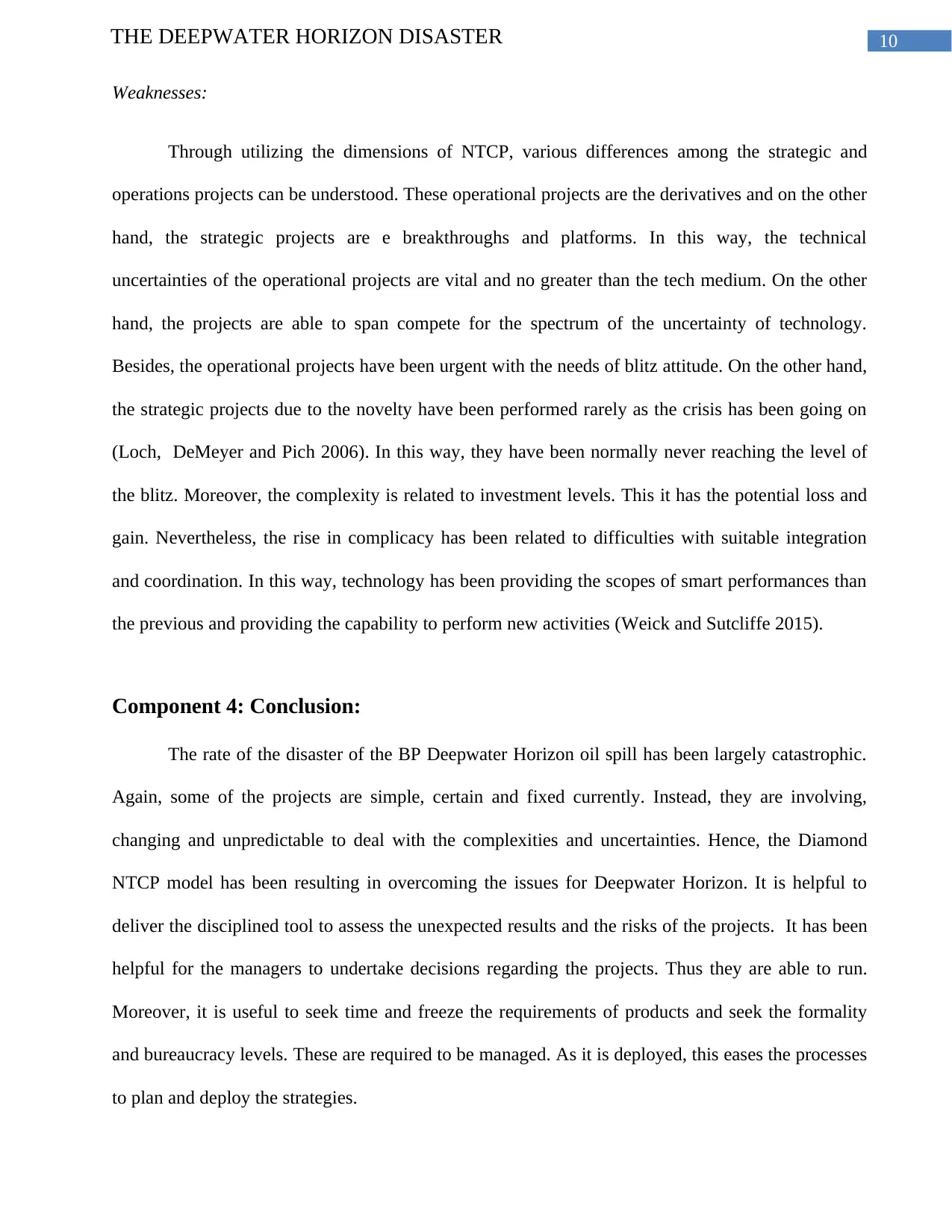
10THE DEEPWATER HORIZON DISASTER
Weaknesses:
Through utilizing the dimensions of NTCP, various differences among the strategic and
operations projects can be understood. These operational projects are the derivatives and on the other
hand, the strategic projects are e breakthroughs and platforms. In this way, the technical
uncertainties of the operational projects are vital and no greater than the tech medium. On the other
hand, the projects are able to span compete for the spectrum of the uncertainty of technology.
Besides, the operational projects have been urgent with the needs of blitz attitude. On the other hand,
the strategic projects due to the novelty have been performed rarely as the crisis has been going on
(Loch, DeMeyer and Pich 2006). In this way, they have been normally never reaching the level of
the blitz. Moreover, the complexity is related to investment levels. This it has the potential loss and
gain. Nevertheless, the rise in complicacy has been related to difficulties with suitable integration
and coordination. In this way, technology has been providing the scopes of smart performances than
the previous and providing the capability to perform new activities (Weick and Sutcliffe 2015).
Component 4: Conclusion:
The rate of the disaster of the BP Deepwater Horizon oil spill has been largely catastrophic.
Again, some of the projects are simple, certain and fixed currently. Instead, they are involving,
changing and unpredictable to deal with the complexities and uncertainties. Hence, the Diamond
NTCP model has been resulting in overcoming the issues for Deepwater Horizon. It is helpful to
deliver the disciplined tool to assess the unexpected results and the risks of the projects. It has been
helpful for the managers to undertake decisions regarding the projects. Thus they are able to run.
Moreover, it is useful to seek time and freeze the requirements of products and seek the formality
and bureaucracy levels. These are required to be managed. As it is deployed, this eases the processes
to plan and deploy the strategies.
Weaknesses:
Through utilizing the dimensions of NTCP, various differences among the strategic and
operations projects can be understood. These operational projects are the derivatives and on the other
hand, the strategic projects are e breakthroughs and platforms. In this way, the technical
uncertainties of the operational projects are vital and no greater than the tech medium. On the other
hand, the projects are able to span compete for the spectrum of the uncertainty of technology.
Besides, the operational projects have been urgent with the needs of blitz attitude. On the other hand,
the strategic projects due to the novelty have been performed rarely as the crisis has been going on
(Loch, DeMeyer and Pich 2006). In this way, they have been normally never reaching the level of
the blitz. Moreover, the complexity is related to investment levels. This it has the potential loss and
gain. Nevertheless, the rise in complicacy has been related to difficulties with suitable integration
and coordination. In this way, technology has been providing the scopes of smart performances than
the previous and providing the capability to perform new activities (Weick and Sutcliffe 2015).
Component 4: Conclusion:
The rate of the disaster of the BP Deepwater Horizon oil spill has been largely catastrophic.
Again, some of the projects are simple, certain and fixed currently. Instead, they are involving,
changing and unpredictable to deal with the complexities and uncertainties. Hence, the Diamond
NTCP model has been resulting in overcoming the issues for Deepwater Horizon. It is helpful to
deliver the disciplined tool to assess the unexpected results and the risks of the projects. It has been
helpful for the managers to undertake decisions regarding the projects. Thus they are able to run.
Moreover, it is useful to seek time and freeze the requirements of products and seek the formality
and bureaucracy levels. These are required to be managed. As it is deployed, this eases the processes
to plan and deploy the strategies.
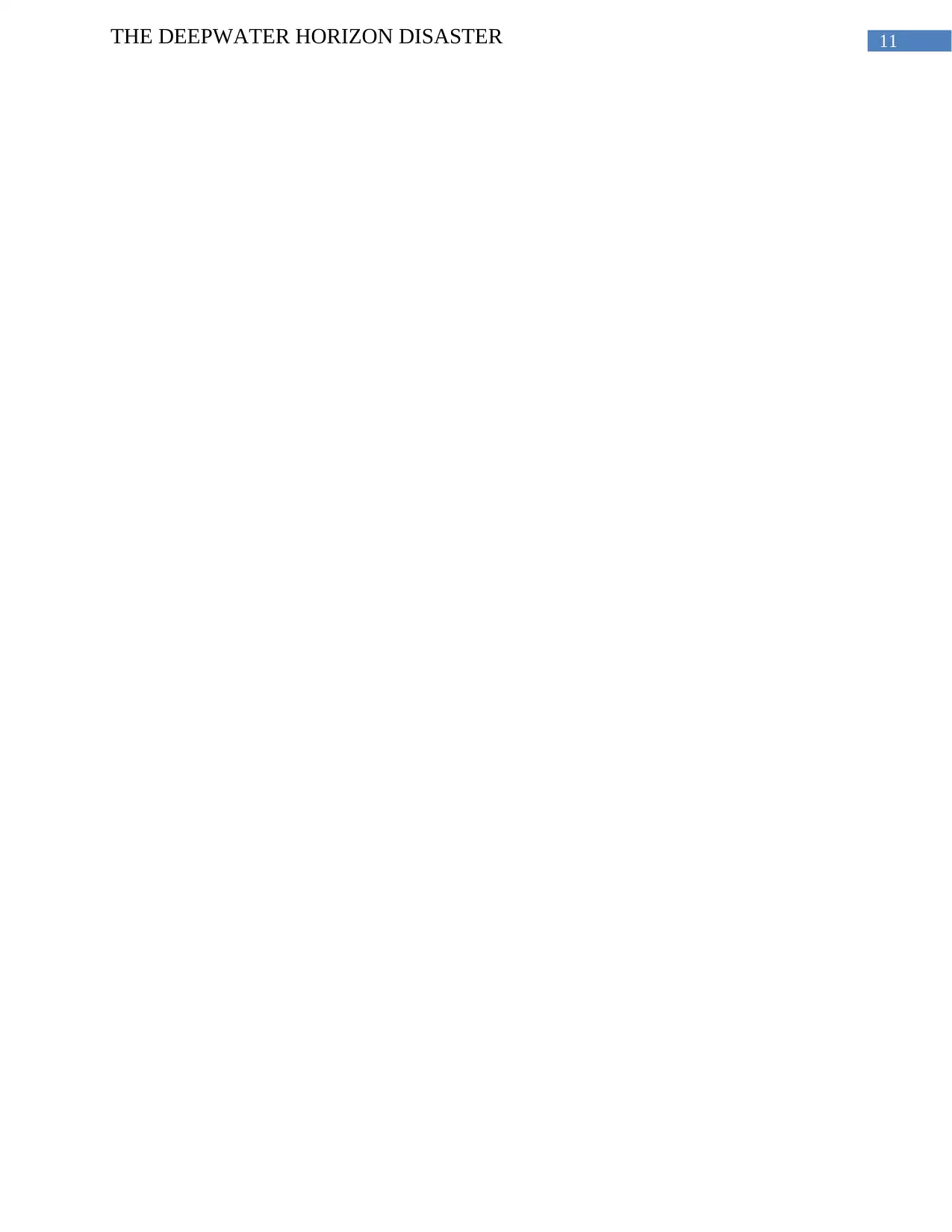
11THE DEEPWATER HORIZON DISASTER
⊘ This is a preview!⊘
Do you want full access?
Subscribe today to unlock all pages.

Trusted by 1+ million students worldwide
1 out of 23
Related Documents
Your All-in-One AI-Powered Toolkit for Academic Success.
+13062052269
info@desklib.com
Available 24*7 on WhatsApp / Email
![[object Object]](/_next/static/media/star-bottom.7253800d.svg)
Unlock your academic potential
Copyright © 2020–2025 A2Z Services. All Rights Reserved. Developed and managed by ZUCOL.




